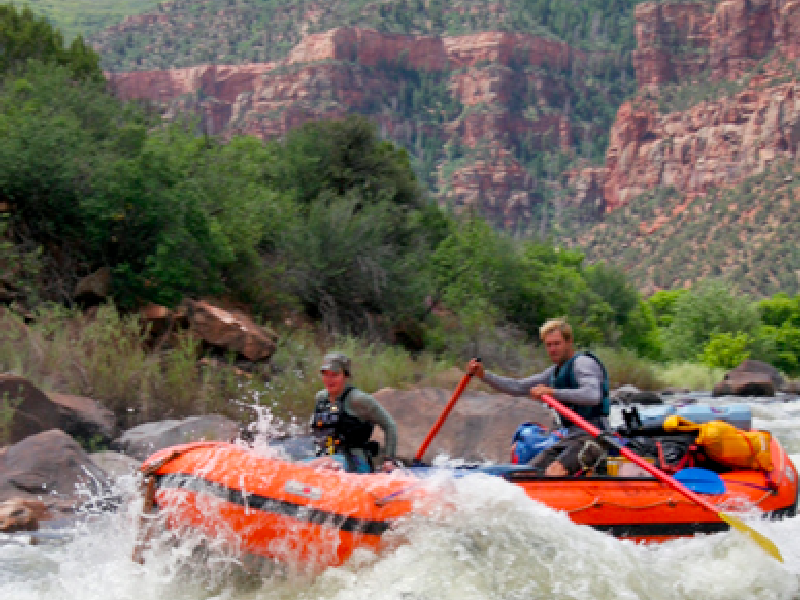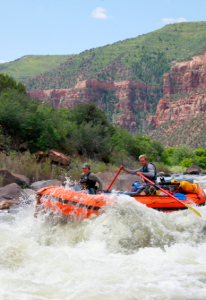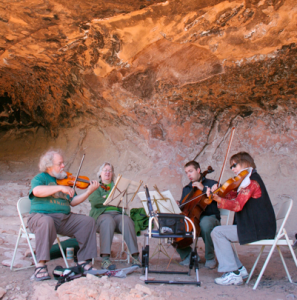Whitewater, Meet the Classics. Classics, Say Hello to Whitewater
- Posted On
- Jan 14, 2014
- Category
- Southern Utah
Bill and Jaci Dvorak own and operate Dvorak Expeditions, a commercial guide service with regularly scheduled rafting trips on some of west's best whitewater rivers. Two of the better ones are multi-day trips on Utah's mighty Green River through Desolation Canyon, and on the Dolores, which begins near Cortez in the southwest corner of Colorado near Cortez, flows northwest and crosses the state line into the Colorado River at Dewey, Utah, upriver from Moab. Both rivers feature plenty of whitewater excitement. The Green has dozens of Class III rapids and the infamous Snaggletooth Rapid on the Dolores is one of the great western whitewater runs.
The Dolores River is an enigma. Imagine a place where cell phones don't ring, faxes are non-existent and modems won't dial up. The only traffic you'll encounter is an occasional Blue Heron flying overhead. A place so quiet that if you close your eyes you can almost hear the chanting of the ancients who inhabited the area millennia ago. There's a spiritual quality about this place. Let the stress of everyday life drain from your body as you ponder the enchantment of this place. This place is the Dolores River, in the heart of Utah's Canyon country, and one of the world's best-kept secrets. Only a handful of adventurers experience this great stretch of water, mainly because of its remoteness.
The river running season on the Dolores is limited to the spring run-off period, usually late April through early June. During that time, releases are made from the McPhee Dam to allow for the influx of snowmelt into the reservoir it holds. One big advantage – river runners are guaranteed a spectacular wildflower show – everything from flowering cacti and Indian paintbrush to desert primrose blossoms. With a span of 173 uninterrupted river miles below the reservoir, the Dolores is second only to the Grand Canyon in length in the lower 48.
And then there's the Green. The waters of the mighty Green River originate near the continental divide in the Wind River Mountain range of central Wyoming and travel 730 miles into the Gulf of California, meandering through nearly 450 miles of Utah's scenic landscapes. An 86-mile stretch of the Green includes two of the most remote and isolated wilderness river canyons in the lower 48 states, Desolation and Grey Canyons. The ribbon of water begins tranquilly in the Utah desert and gradually courses deeper and deeper into red sandstone canyons. In fact, at one point near crystal-clear Rock Creek, Deso (as river guides call it) is as deep as the Grand Canyon at Bright Angel Trail. Over one mile!
The Green River corridor has a rich history. The Fremont Culture, who thrived from the 7th to the 13th Centuries, made their homes in the tributary canyons of the river valley and left behind volumes of brilliant rock art on canyon walls. Centuries later, the Shoshone culture inhabited the river valley north of the Uintah Mountains and named the river the Seeds-kee-dee-Agie, meaning "Prairie Hen River." In 1869, John Wesley Powell embarked on the first of two epic voyages down the Green, floating the river to the confluence with the Colorado. Powell named most of the canyons, geographic features and rapids along the Green, leaving behind a detailed account of the river for future explorers and river-runners.
With these two great river corridors, their rich histories, unmatched beauty and whitewater excitement, what could possibly make for a better river adventure?
Read on!
Two of Dvorak Expeditions river trips are unlike any other. Classical music aficionados will immediately recognize Bill's surname as the same as the great Czech composer from Bohemia, Antonin (Anton) Dvořák whose works include the orchestral Slavonic Dances and Slavonic Rhapsodies, and several concertos for violin, cello and piano. The composer's most famous work, however, is the stirring and melodic Symphony #9 in E Minor, Op. 95, "From the New World."
Bill is a direct descendant of Anton Dvořák. Twice a year, once each on the Green and the Dolores, his company treats lucky river runner guests to nightly on-shore concerts performed by a classical string quartet. Accomplished concert musicians from some of the country's leading symphonies and philharmonic orchestras apply to be listed on the roster from which Bill and Jaci select the quartet. Works performed include not only those of his famed ancestor, but of many other classical composers, Beethoven, Mozart, Handel, Bartok, Hayden and Bach and works of modern day artists such as Gershwin, Henry Mancini, Duke Ellington, Kurt Weill and other popular favorites.
Barry and Judy have been members of the Los Angeles Philharmonic for the past 28 years. Connie is with the Los Angeles Chamber Orchestra and Brook is in his fourth year at the prestigious Curtis Institute of Music in Philadelphia. This quartet performed in spectacular river corridor backdrops for a diverse and eclectic audience of river runners and music aficionados: Karl & Mary, a neurophysiologist and a nurse; Jackie, a seventh grade teacher; Nancy, an architect; Rob, a professor of anthropology; Val, a family practice physician; Martha, a clinical psychologist; Jennifer, an internal medicine physician; Karen, a former skiwear designer; Carl, an award winning photographer. And oh, yes. For Bill Dvorak and his wonderful crew of four; Samantha, Amy, Evan and Mafro, four engaging, bright young people who not only can read and navigate a river, but also happen to be great cooks!
Archives
- 2023
- 2022
- 2021
- 2020
- 2019
- 2018
- 2017
- 2016
- 2015
- 2014
- 2013
- 2012
- 2011
- 2010



